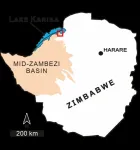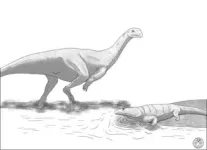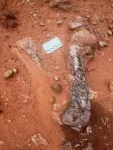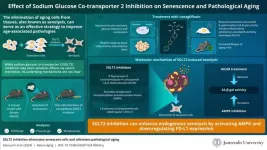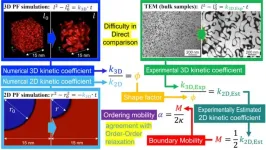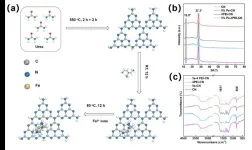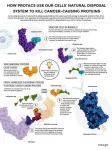(Press-News.org) Fossils found on the shoreline of Lake Kariba in Zimbabwe represent a completely new dinosaur species. This remarkable find, named Musankwa sanyatiensis, marks only the fourth dinosaur species named from Zimbabwe. The research detailing this significant discovery is set to be published in the prestigious journal Acta Palaeontologica Polonica. The study was conducted by an international team of scientists from the University of the Witwatersrand (Wits) in South Africa, the Natural History Museum of Zimbabwe, Stony Brook University in New York and was led by Prof Paul Barrett from the Natural History Museum in London.
The discovery of Musankwa sanyatiensis is particularly significant as it is the first dinosaur to be named from the Mid-Zambezi Basin of northern Zimbabwe in over 50 years. Additionally, it is only the fourth dinosaur to be named from Zimbabwe, following the descriptions of “Syntarsus” rhodesiensis in 1969, Vulcanodon karibaensis in 1972, and, most recently, Mbiresaurus raathi in 2022.
The rocks yielding this new specimen date back to the Late Triassic period, approximately 210 million years ago. Musankwa sanyatiensis is represented by the remains of a single hind leg, including its thigh, shin, and ankle bones. “Despite the limited fossil material, these bones possess unique features that distinguish them from those of other dinosaurs living at the same time,” says Dr Kimberley ‘Kimi’ Chapelle, assistant professor at Stony Brook University and an honorary associate at the Evolutionary Studies Institute at Wits.
The discovery was named Musankwa sanyatiensis after the houseboat "Musankwa”. In the Tonga dialect, "Musankwa" means "boy close to marriage". This vessel served as the research team's home and mobile laboratory during two field expeditions to Lake Kariba in 2017 and 2018. The vessel was made available to the research team through the generosity of David and Julie Glynn, and the crew – Coster Katupu, Godfrey Swalika, Simbarashe Mangoroma, and Never Mapira – who provided essential logistic support.
Evolutionary analysis reveals that Musankwa sanyatiensis was a member of the Sauropodomorpha, a group of bipedal, long-necked dinosaurs that were widespread during the Late Triassic. Interestingly, this dinosaur appears to be closely related to contemporaries in South Africa and Argentina. Weighing in at around 390 kg, the plant-eating Musankwa sanyatiensis was one of the larger dinosaurs of its era.
Africa has a long history of dinosaur discovery, with the first dinosaur in the southern hemisphere found in South Africa just three years after the term "dinosaur" was coined by Sir Richard Owen in 1842. However, most known dinosaur fossils have been found in just 10 countries, particularly in the northern hemisphere, leading to a sparse representation of African dinosaur diversity in the global fossil record. “The main reason for the underrepresentation of African dinosaur fossils is ‘undersampling’,” says Barrett. “Put simply, there have been fewer people looking for and unearthing dinosaurs in comparison with other regions of the world,” he notes.
Despite the fewer discoveries in Africa, many of these fossils are historically and scientifically significant. These include some of the oldest dinosaurs like Nyasasaurus parringtoni from Tanzania and Mbiresaurus raathi from Zimbabwe, as well as rich dinosaur faunas from South Africa, Tanzania, Niger, and Morocco.
The Late Triassic-Early Jurassic sediments of Zimbabwe are crucial for understanding the End-Triassic extinction, a catastrophic event that dramatically reshaped Earth's biodiversity around 200 million years ago. These different layers provide insights into how different fossil-bearing sediments around the world correspond in age and help in piecing together the global picture of prehistoric life.
This new dinosaur species also highlights the untapped potential of the region for further paleontological discoveries. Barrett elaborates: “Over the last six years, many new fossil sites have been recorded in Zimbabwe, yielding a diverse array of prehistoric animals, including the first sub-Saharan mainland African phytosaurs (ancient crocodile-like reptiles), metoposaurid amphibians (giant armoured amphibians), lungfish, and other reptile remains”.
As more fossil sites are explored and excavated, there is hope for uncovering further significant finds that will shed light on the early evolution of dinosaurs and the ecosystems they inhabited. “Based on where it sits on the dinosaur family tree, Musanwka sanyantiensis is the first dinosaur of its kind from Zimbabwe,” Dr Kimi Chapelle excitedly explains. “It, therefore, highlights the potential of the region for further palaeontological discoveries,” she says.
END
Musankwa sanyatiensis, a new dinosaur from Zimbabwe
A new Late Triassic sauropodomorph dinosaur discovered in the Mid-Zambezi Basin, Zimbabwe
2024-05-30
ELSE PRESS RELEASES FROM THIS DATE:
Statin therapy may prevent cancer by blocking inflammatory protein
2024-05-30
BOSTON – A new study led by investigators from Mass General Cancer Center, a founding member of the Mass General Brigham healthcare system, reveals that statins—commonly used cholesterol-lowering drugs—may block a particular pathway involved in the development of cancer that results from chronic inflammation. The findings are published in Nature Communications.
“Chronic inflammation is a major cause of cancer worldwide,” said senior author Shawn Demehri, MD, PhD, a principal investigator at the Center for Cancer Immunology and Cutaneous Biology Research Center of Massachusetts General Hospital and an associate professor of Dermatology at ...
A novel ‘senolytic’ strategy for treating aging-related diseases
2024-05-30
The process of aging is accompanied by a decline in physiological functions, which can lead to cardiovascular, neurodegenerative, and metabolic diseases. Aging of cells, also known as ‘cellular senescence’— is a process in which a cell ages and permanently stops dividing but does not die. The accumulation of such ‘senescent’ cells in tissues is then known to contribute to age-associated diseases. Elimination of senescent cells or ‘senolysis’ can, therefore, serve as an effective therapeutic strategy for the improvement of physiological function and prevention ...
Risk of death from COVID-19 lessens, but infection still can cause issues 3 years later
2024-05-30
New findings on long COVID — long-term effects on health experienced by many who have had COVID-19 — present a good-news, bad-news situation, according to a study at Washington University School of Medicine in St. Louis and the Veterans Affairs St. Louis Health Care system.
The bad news: COVID-19 patients who were hospitalized within the first 30 days after infection face a 29% higher risk of death in the third year compared with people who have not had the virus. However, the three-year death risk still marks a significant decline compared with such risk at the one- and two-year marks post-infection. The findings also show that even people with mild COVID-19 were still ...
Combining simulations and experiments to get the best out of Fe3Al
2024-05-30
Osaka, Japan – The compound of iron and aluminum with the chemical formula Fe3Al has some very useful mechanical properties. A team from Osaka University has combined simulations with experimental techniques to better understand the kinetics of the formation of microstructures to enhance and utilize these properties and how to harness them for specific applications.
In a study recently published in Acta Materialia, the researchers took an in-depth look at the way the microstructure of Fe3Al develops because the ordered domains that form contribute to one of its key properties: superelasticity.
When high loads are applied to superelastic materials they ...
Both high performance and stability were achieved with multifunctional materials!
2024-05-30
Through joint research with Professor Chul-jin Ahn’s team at Changwon National University, the research team of Dr. Jae-Ho Kim and Dr. Myung-kwan Song from the Department of Energy & Electronic Materials in the Surface & Nano Materials Division has developed a 4-Amino-TEMPO derivative with photocatalytic properties and successfully used it to produce high-performance and stable fiber-shaped dye-sensitized solar cells (FDSSCs) and fiber-shaped organic light-emitting diodes (FOLEDs). The developed 4-Amino-TEMPO derivative has the characteristic of simultaneously improving the performance of both fiber-shaped dye-sensitized solar cells (FDSSCs) and fiber-shaped ...
Structural inequities amplify homelessness challenges for pregnant people in Washington DC
2024-05-30
WASHINGTON -- New research conducted with Washington, DC, residents who experienced homelessness during pregnancy sheds light on the intersection of homelessness, pregnancy, and racial inequities. The findings underscore the urgent need for policy and practice changes to support vulnerable populations.
The study, published May 30, 2024 in the journal Health Equity (DOI: 10.1089/heq.2023.0235), is grounded in a reproductive justice framework and delves into the lived experiences of 20 DC residents who faced homelessness while pregnant.
Homelessness ...
University of Maryland study shows N95 masks near-perfect at blocking escape of airborne COVID-19
2024-05-30
COLLEGE PARK, Md. – In a head-to-head comparison of masks worn by people with active
COVID-19, the inexpensive “duckbill” N95 came out on top, stopping 98% of COVID-19 particles
in the breath of infected people from escaping into the air. Led by researchers from the University
of Maryland School of Public Health (SPH), results showed other masks also performed well,
blocking at least 70% of viral particles from escaping from the source – an infected person’s
exhaled breath.
The study, Relative efficacy of masks and respirators as source control for viral aerosol shedding
from people infected with SARS-CoV-2, published May 29 in eBioMedicine, a Lancet ...
The AI paradox: Building creativity to protect against AI
2024-05-30
Cultivating creativity in schools is vital for a future driven by artificial intelligence (AI). But while teachers embrace creativity as an essential 21st century skill, a lack of valid and reliable creativity tests means schools struggle to assess student achievement.
Now, a new machine-learning model developed by the University of South Australia is providing teachers with access to high-quality, fit-for-purpose creativity tests, that can score assessments in a fraction of the time and a fraction of the cost.
Applied to the current ...
Visible light-induced photocatalysis–self-Fenton degradation of P-Clphoh over graphitic carbon nitride by a polyethylenimine bifunctional catalyst
2024-05-30
The deep degradation of organic pollutants through solar light-coupled photocatalysis and the Fenton reaction (Photo-Fenton) holds significant importance in the field of water purification. In this study, a novel bifunctional catalyst (Fe-PEI-CN) was synthesized by electrostatic self-assembly and hydrothermal methods, doping graphene-like carbon nitride (CN) with polyethyleneimine (PEI) and iron (Fe) species. This catalyst efficiently degraded p-chlorophenol (p-ClPhOH) by generating hydrogen peroxide (H2O2) during the photocatalytic process. The relationship between catalytic efficiency and structure was explored using various characterization techniques.Under ...
Engineered DNA 'warhead' targets a common cancer mutation
2024-05-30
Tumour protein P53 (TP53) plays an important role in suppressing the growth of tumours. Mutations in the gene for TP53 can have a disastrous effect, hampering the body's ability to fight tumours and even encouraging their growth. Because these are the most common mutations in cancers, TP53 has long been an interesting therapeutic target. However, efforts to destroy the mutant protein have been hampered by the difficulty of finding a way to bind to it.
Now, a team of researchers from Xi'an ...
LAST 30 PRESS RELEASES:
Why are there so many Nordic mediators?
Young shark species more vulnerable to extinction
Mobile fetal heart monitoring linked to fewer newborn deaths in Tanzania
Bluey’s dad offered professorial chair in archaeology at Griffith University
Beyond small data limitations: Transfer learning-enabled framework for predicting mechanical properties of aluminum matrix composites
Unveiling non-thermal catalytic origin of direct current-promoted catalysis for energy-efficient transformation of greenhouse gases to valuable chemicals
Chronic breathlessness emerging as a hidden strain on hospitals
Paleontologists find first fossil bee nests made inside fossil bones
These fossils were the perfect home for ancient baby bees
Not everyone reads the room the same. A new study examines why.
New research identifies linked energy, immune and vascular changes in ME/CFS
Concurrent frailty + depression likely boost dementia risk in older people
Living in substandard housing linked to kids’ missed schooling and poor grades
Little awareness of medical + psychological complexities of steroid cream withdrawal
Eight in 10 trusts caring for emergency department patients in corridors, finds BMJ investigation
NASA’s Webb telescope finds bizarre atmosphere on a lemon-shaped exoplanet
The gut bacteria that put the brakes on weight gain in mice
Exploring how patients feel about AI transcription
Category ‘6’ tropical cyclone hot spots are growing
Video: Drivers struggle to multitask when using dashboard touch screens, study finds
SLU research shows surge in alcohol-related liver disease driving ‘deaths of despair’
Rising heat reshapes how microbes break down microplastics, new review finds
Roots reveal a hidden carbon pathway in maize plants
Membrane magic: FAMU-FSU researchers repurpose fuel cells membranes for new applications
UN Member States pledge to increase access to diagnosis and inhaled medicines for the 480 million people living with COPD
Combination therapy shows potential to treat pediatric brain cancer ATRT
Study links seabird nesting to shark turf wars in Hawai‘i
Legal sports betting linked to sharp increases in violent crime, study finds
Breakthrough AI from NYUAD speeds up discovery of life-supporting microbes
New Eva Mayr-Stihl Foundation funding initiative boosts research at University of Freiburg on adaptation of forests to global change
[Press-News.org] Musankwa sanyatiensis, a new dinosaur from ZimbabweA new Late Triassic sauropodomorph dinosaur discovered in the Mid-Zambezi Basin, Zimbabwe
